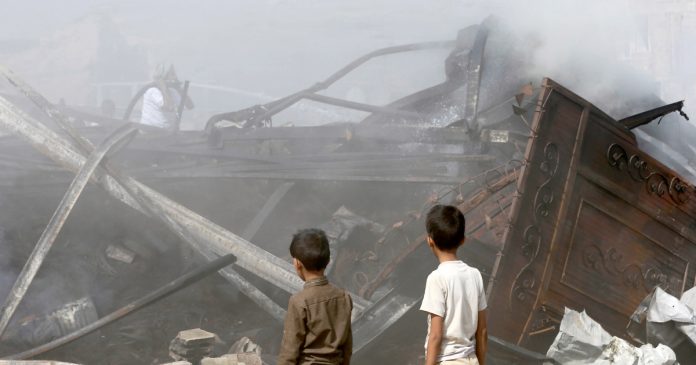[ad_1]
United States President Joe Biden last week announced plans to end US support for Saudi Arabia’s “offensive operations” in war-torn Yemen, including ceasing relevant arms sales to the government in Riyadh.
The move signalled a distinct shift in Washington’s approach to the conflict and a renewed emphasis on reaching a diplomatic solution to the years-long war, which has caused what the United Nations describes as the world’s worst humanitarian crisis.
But since the announcement on Thursday, the Biden administration has released few details on what support to Saudi Arabia-led coalition forces in Yemen it plans to end – or how it will differentiate it from other US assistance and arms sales to Saudi Arabia.
“The United States provides spare parts, munitions, technical assistance, all kinds of things to the Saudi military, which enable its offensive operations,” Bruce Riedel, a senior fellow at the Brookings Institution, told Al Jazeera.
“So if the Saudis continued to use the Royal Saudi Air Force to bomb targets in Yemen, presumably, under this doctrine, that aid and assistance should halt.”
The US began providing “logistical and intelligence support” to the Saudi Arabia-led coalition in Yemen in March 2015, shortly after Saudi Arabia and the United Arab Emirates (UAE) launched a military offensive in support of President Abd-Rabbu Mansour Hadi, who was overthrown by the Houthi rebels.
That support included the creation of a joint US-Saudi “planning cell” to coordinate military and intelligence assistance, technical support for US-purchased air fleets, and initially, in-air refuelling of Saudi aircraft.
The entrenched fighting, a blockade imposed by Riyadh, and Saudi air attacks have exacted a bloody toll on Yemenis, with thousands of civilians killed and a humanitarian disaster pushing 13.5 million people to the brink of starvation. Both the Saudi Arabia-led coalition and Houthi rebels have been accused of committing war crimes.
But since the war began, Saudi Arabia has remained the largest importer of US arms in the world, with major imports growing by 130 percent from 2015 to 2019, compared with the previous five-year period, according to the Stockholm International Peace Research Institute.
During the same period, 73 percent of Saudi Arabia’s arms imports came from the US.
 A Houthi detention centre was destroyed by Saudi Arabia-led coalition air attacks, killing at least 60 people and wounding several dozen in Dhamar province in September 2019 [File: Hani Mohammed/TAP Photo]
A Houthi detention centre was destroyed by Saudi Arabia-led coalition air attacks, killing at least 60 people and wounding several dozen in Dhamar province in September 2019 [File: Hani Mohammed/TAP Photo]
The US Department of Defense said on Friday that the US intelligence assistance to the Saudi Arabia-led coalition, which was largely related to air attacks, would cease.
The Biden administration will go through an “interagency process” to determine what constitutes “offensive” support for the coalition, as well as to evaluate individual arms sales, State Department spokesman Ned Price said at a news conference that same day.
But Riedel said many questions remain, including a critical one related to easing the humanitarian crisis in Yemen: Will the announcement encompass ceasing any intelligence or other support for Riyadh’s blockade on the country?
The blockade, first imposed in 2015, closed land, air and seaports to Yemen, but has been intermittently eased amid condemnation over the humanitarian crisis it has wrought. “As long as the blockade is in place, millions of Yemenis will be at risk,” said Riedel.
“[Is the US] going to provide support for the Saudi navy to continue that? Are we going to give them intelligence on shipments from Iran to the Houthis?”
Longstanding US support
Biden’s move is a hard pivot from the support for the Saudi-led coalition in Yemen that began under his former boss, President Barack Obama, and expanded under his immediate predecessor, President Donald Trump.
Joshua Landis, director of the Center for Middle East Studies at Oklahoma University, said the US support for the Saudi Arabia-led coalition in Yemen was “Obama’s way to trade for the Iran [nuclear] deal”, which was reached in July 2015. “That was the original mistake,” Landis said.
In 2015, the Obama administration was mostly silent as Riyadh aggressively opposed a Dutch-led push for a human rights inquiry in Yemen. The US also did not step up when Riyadh reportedly threatened to pull UN funding if the organisation did not remove it from a list of violators of children’s rights for its actions in Yemen in 2016.
At the end of his term, the Obama administration briefly paused some arms deals to Riyadh following a Saudi air raid on a funeral in Sanaa killed 140 people in October 2016.
But the US support for the Saudi campaign in Yemen increased under Trump, who was a staunch ally of Saudi Arabia and Crown Prince Mohammed bin Salman, in particular. Upon taking office, Trump announced plans to increase training for the Saudi air force.
Trump also authorised $27.4bn in US arms sales to Saudi Arabia during his first three years in office, a May 2020 Security Assistance Monitor report found. “The Trump administration has concluded two major deals for precision-guided bombs to Saudi Arabia of the type being used in its brutal war in Yemen, as well as upgrades of its US-supplied F-15 aircraft that are a bulwark of the Saudi air war in Yemen,” the report said.
In 2018, amid mounting international pressure to end the war, then-Secretary of Defense James Mattis said the US would no longer conduct in-flight refuelling for Saudi aircraft – after Saudi Arabia said it had developed its own capacity and no longer needed Washington’s help.
Trump continued to stand by Saudi Arabia in 2019, vetoing a resolution passed by the House of Representatives and the Senate that called for an end to the US support for the Saudi Arabia-led coalition.
As of June 2020, the Trump administration reported to Congress that the US military “continued to provide military advice and limited information, logistics, and other support to regional forces combating the Houthis in Yemen”.
Which weapons are ‘offensive’?
The Biden administration has already paused pending Trump-era arms sales to the UAE and Saudi Arabia, calling the move a “typical” re-evaluation by a new administration. Still, two pending deals for GBU-39 Small Diameter Bombs and precision-guided missiles, are expected to be terminated under the announcement.
Further arms deals will likely be part of “an ongoing negotiation” as the US works towards a larger diplomatic effort to end the conflict in Yemen, said Landis.
That effort includes the appointment of Tim Lenderking as the Biden administration’s new envoy to Yemen and plans to lift the US designation of the Houthi movement as a “foreign terrorist organization”, which has been derided for stalling aid to Yemenis.
“So many of these weapons are fungible,” Landis said. “They could be for defence or offence.”
He added the Biden administration will be involved in a “delicate game” as it tries to up pressure on Saudi Arabia without driving the country towards further belligerence in Yemen or into the arms of Russia and China.
That means Biden may come up short of enacting a more lasting ban on arms sales.
“A lot of it’s going to be optics,” he said. “There’s gonna be a lot of smoke and mirrors, and a lot of head fakes by the Biden administration.”
‘Not take the foot off the gas’
Meanwhile, the work continues for grassroots organisations that for years have urged the US to end its support for Saudi Arabia-led forces in Yemen, said Hassan el-Tayyab, a Middle East policy lobbyist at the Friends Committee on National Legislation (FCNL).
El-Tayyab said the Biden administration’s announcement is a good first step, but activists want the US to end all forms of assistance to the coalition.
“This means [ending] intel sharing for Saudi-led coalition air strikes and spare parts transfers that keep warplanes in the air. It means [ending] targeting assistance and logistical support and maintenance,” he told Al Jazeera.
 Malnourished Hassan Merzam Muhammad lies on a bed at his family’s hut in Abs district of Hajjah province, Yemen in November 2020 [File: Eissa Alragehi/Reuters]
Malnourished Hassan Merzam Muhammad lies on a bed at his family’s hut in Abs district of Hajjah province, Yemen in November 2020 [File: Eissa Alragehi/Reuters]
El-Tayyab said “offensive weapons” also need to be clearly defined, and added that he wants to make sure weapons such as Reaper drones and F-35s that the Trump administration agreed to sell the UAE are included in any ban.
“I’m not a full pessimist here. I welcome the news,” he told Al Jazeera. “But I’m just trying to stay vigilant and not take the foot off the gas on advocacy pressure. Because we don’t know what’s going to happen.”
[ad_2]
Source link











